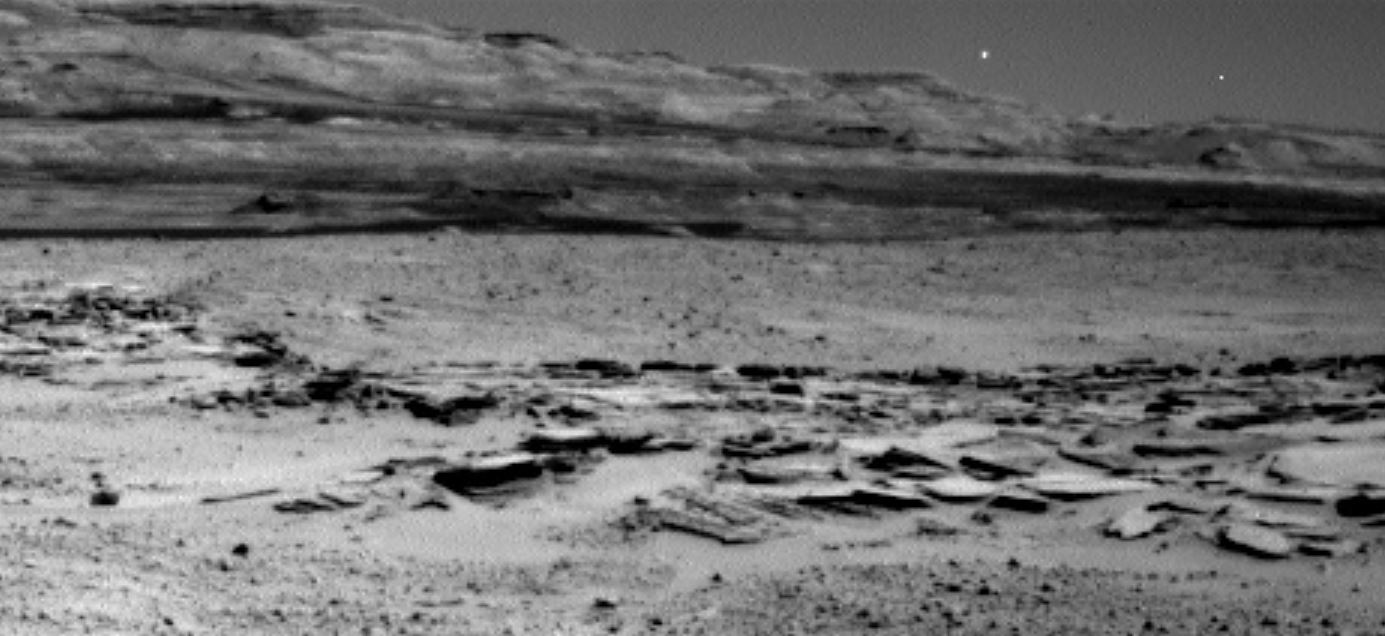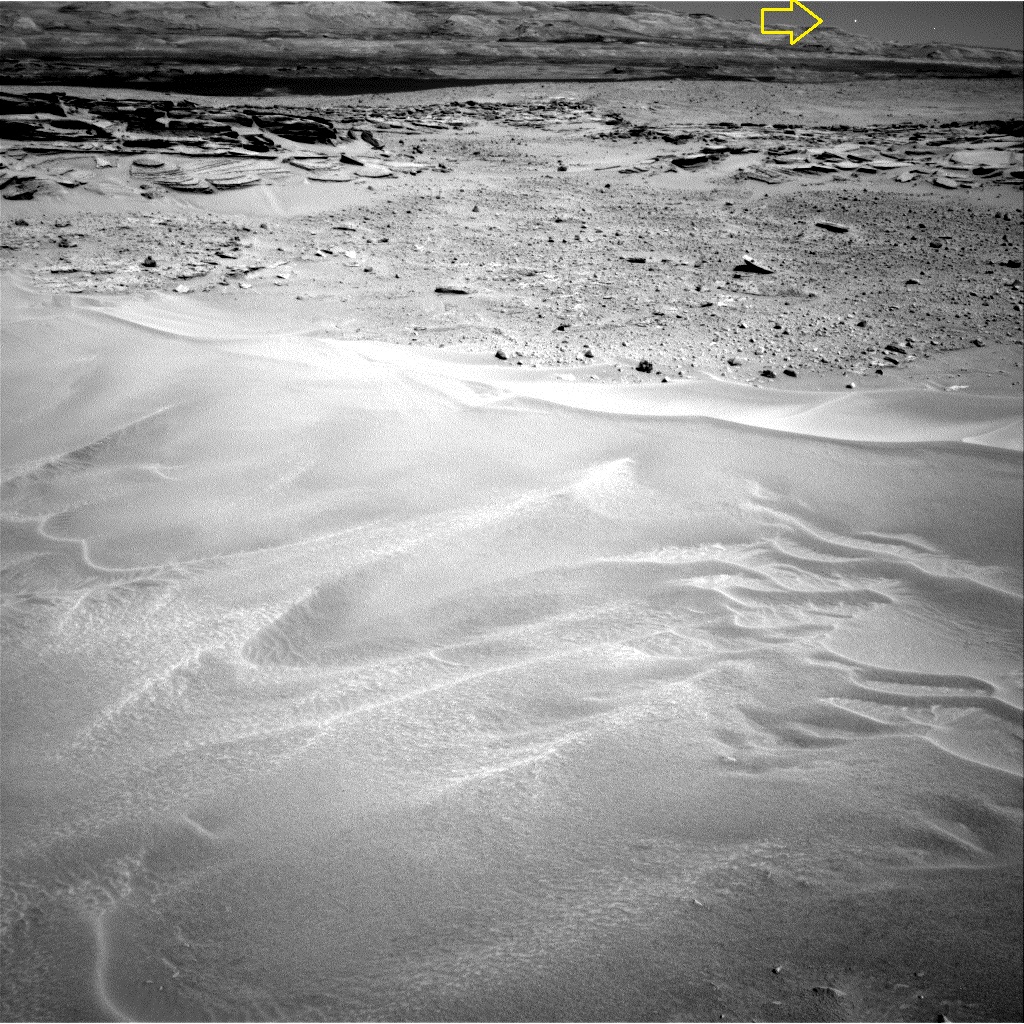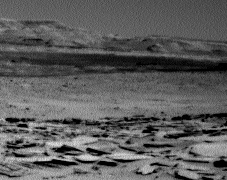It looks like you're using an Ad Blocker.
Please white-list or disable AboveTopSecret.com in your ad-blocking tool.
Thank you.
Some features of ATS will be disabled while you continue to use an ad-blocker.
share:
A third mysterious source of light (a couple of shining objects) detected by the Rover Curiosity, right above the slopes at the horizon on Sol 603.
mars.jpl.nasa.gov... Two different
bright lights hovering above Mount Sharp.
Recently seems Gale Crater is an "Hot Spot" for this kind of sightings...



Busy. Busy time for the "cosmic rays" in these days on Gale Crater.
Sarcasm apart, it's time for NASA/JPL/MSSS give a clear explanation on what really happen in these days on Gale Crater.
Last Related Threads on this topic:
www.abovetopsecret.com...
www.abovetopsecret.com...
Recently seems Gale Crater is an "Hot Spot" for this kind of sightings...



Busy. Busy time for the "cosmic rays" in these days on Gale Crater.
Sarcasm apart, it's time for NASA/JPL/MSSS give a clear explanation on what really happen in these days on Gale Crater.
Last Related Threads on this topic:
www.abovetopsecret.com...
www.abovetopsecret.com...
My guess would be stars, as they are hanging up in the sky. I would assume that you can still see stars from mars, one of those dots could be earth
perhaps.
Interesting nonetheless
Interesting nonetheless
a reply to: knoledgeispower
according to the "new crowd" here on ATS, these could be cosmic rays.....
But who knows really...
If it's not man made, then I'm not sure what else it could be?
according to the "new crowd" here on ATS, these could be cosmic rays.....
But who knows really...
Maybe you should pull up the coords of that pic in Stellarium and rule out moons and stars before jumping on this dead horse again.
Rule everything out FIRST, then go off the deep end if you can't verify (not beforehand)
Rule everything out FIRST, then go off the deep end if you can't verify (not beforehand)
I dont buy the cosmic ray thing. Nothing I've read about them gives me the notion that they are visible to the naked eye. Cant find a picture of
any. Just hypothetical drawings. None of em look like specks of light or geysers of light erupting from the surface. As for what it might be I dont
have any answer for that. I'm just making a statement because people always says cosmic ray but I'm wondering what pictures they use to base their
assumptions off of. Mars does have 2 moons that are rather small...the size of asteroids. Thats my best guess.
a reply to: rustyclutch
Things like this. It is an image taken of the sky of Mars at night.
mars.jpl.nasa.gov...
They aren't. But a digital camera is not a naked eye.
. Nothing I've read about them gives me the notion that they are visible to the naked eye.
I'm wondering what pictures they use to base their assumptions off of.
Things like this. It is an image taken of the sky of Mars at night.
mars.jpl.nasa.gov...
sorry arken, this one is nothing like the other lights.
is it in only one cam?
one is a dot of light the other is smudged.
i like your finds and don't like to rain on parades.
what they are? hell if i know.
is it in only one cam?
one is a dot of light the other is smudged.
i like your finds and don't like to rain on parades.
what they are? hell if i know.
a reply to: Phage
Yeah I know but if they had been seen with digital cameras prior to this then there would be pictures for me to find easily when I google them. There arent. The best they can do is show some picture of some far away galaxy with gas clouds. When you can show me a legit picture of a cosmic ray I will acknowledge you. Until then you are just giving your opinion. I look forward to those pics.
Yeah I know but if they had been seen with digital cameras prior to this then there would be pictures for me to find easily when I google them. There arent. The best they can do is show some picture of some far away galaxy with gas clouds. When you can show me a legit picture of a cosmic ray I will acknowledge you. Until then you are just giving your opinion. I look forward to those pics.
a reply to: rustyclutch
I just did.
What do you think those spots and streaks are?
When you can show me a legit picture of a cosmic ray I will acknowledge you.
I just did.
What do you think those spots and streaks are?
What do you expect to see in them?
I look forward to those pics.
edit on 4/20/2014 by Phage because: (no reason
given)
a reply to: Arken
Like this?
Well above the horizon:
mars.jpl.nasa.gov...
Well below the horizon:
files.abovetopsecret.com...
All over the place:
mars.jpl.nasa.gov...
Another:
mars.jpl.nasa.gov...
Like this?
Well above the horizon:
mars.jpl.nasa.gov...
Well below the horizon:
files.abovetopsecret.com...
All over the place:
mars.jpl.nasa.gov...
Another:
mars.jpl.nasa.gov...
edit on
4/20/2014 by Phage because: (no reason given)
Third time's the charm? I don't think so. It just shows that it is MORE unlikely that they're light sources.


a reply to: Phage
Your proof of what the object is? Because I find it rather amazing that the only pictures online anywhere of a cosmic ray are from the Mars rover. I want proof of what the object is. Too many people waste their time arguing opinion and giving very little fact. I stated that what I said in my first response was my OPINION. Unless I state is at fact me and you have nothing to debate about. You can give your opinion without dragging me into your speculations. I can make my own speculations. Give me some EVIDENCE and I might consider what you are saying. Showing me another picture of another unidentified object in the sky isnt proof of anything. I asked for a picture of a cosmic ray. Not another picture of a random object on Mars. Still waiting. And a picture of the Mars night sky and all of the stars doesnt classify as a cosmic ray. I want to be able to clearly tell what I am looking at and I want it from a reliable source. If you cant provide these....you have no idea what a cosmic ray looks like either.
Your proof of what the object is? Because I find it rather amazing that the only pictures online anywhere of a cosmic ray are from the Mars rover. I want proof of what the object is. Too many people waste their time arguing opinion and giving very little fact. I stated that what I said in my first response was my OPINION. Unless I state is at fact me and you have nothing to debate about. You can give your opinion without dragging me into your speculations. I can make my own speculations. Give me some EVIDENCE and I might consider what you are saying. Showing me another picture of another unidentified object in the sky isnt proof of anything. I asked for a picture of a cosmic ray. Not another picture of a random object on Mars. Still waiting. And a picture of the Mars night sky and all of the stars doesnt classify as a cosmic ray. I want to be able to clearly tell what I am looking at and I want it from a reliable source. If you cant provide these....you have no idea what a cosmic ray looks like either.
Typical "cosmic rays streaks" can be detected in the dark or during the night. These fast particles hit the camera and leave a "streak". They need
the DARK to be detected with and a complex subtraction of that particular frame.
a reply to: rustyclutch
Tell me what you think it is. You do realize that the picture in OP came from Right Navigation Camera? The "light sources" doesn't appear in the left navigation camera. Both cameras take pictures at the same time.
Tell me what you think it is. You do realize that the picture in OP came from Right Navigation Camera? The "light sources" doesn't appear in the left navigation camera. Both cameras take pictures at the same time.
originally posted by: Phage
a reply to: Arken
Like this?
Well above the horizon:
mars.jpl.nasa.gov...
Well below the horizon:
files.abovetopsecret.com...
All over the place:
mars.jpl.nasa.gov...
Another:
mars.jpl.nasa.gov...
These are not cosmic rays!.....
Thanks for the links.
As I said in the post above:
Typical "cosmic rays streaks" can be detected in the dark or during the night. These fast particles hit the camera and leave a "streak". They need the DARK to be detected with a complex subtraction of intensity and manipulation of that particular frame.
originally posted by: Arken
Typical "cosmic rays streaks" can be detected in the dark or during the night. These fast particles hit the camera and leave a "streak". They need the DARK to be detected with and a complex subtraction of that particular frame.
Where did you hear this?
a reply to: Arken
news.nationalgeographic.com...
Your statement is false. A cosmic ray is able to saturate pixels at day or night and it requires no processing for them to be visible on a digital image.
As I said in the post above:
It turns out that both cosmic rays and glinting rocks are pretty common on Mars. They've been spotted before. Such rocks have been seen in images sent by several of NASA's Mars rovers, and cosmic rays appear in images that Curiosity sends to Earth each week.
news.nationalgeographic.com...
edit on 4/20/2014 by Phage because: (no reason given)
new topics
-
Ode to Artemis
General Chit Chat: 41 minutes ago -
Ditching physical money
History: 4 hours ago -
One Flame Throwing Robot Dog for Christmas Please!
Weaponry: 4 hours ago -
Don't take advantage of people just because it seems easy it will backfire
Rant: 4 hours ago -
VirginOfGrand says hello
Introductions: 5 hours ago -
Should Biden Replace Harris With AOC On the 2024 Democrat Ticket?
2024 Elections: 5 hours ago -
University student disciplined after saying veganism is wrong and gender fluidity is stupid
Education and Media: 8 hours ago -
Geddy Lee in Conversation with Alex Lifeson - My Effin’ Life
People: 9 hours ago -
God lived as a Devil Dog.
Short Stories: 9 hours ago -
Police clash with St George’s Day protesters at central London rally
Social Issues and Civil Unrest: 11 hours ago
top topics
-
Hate makes for strange bedfellows
US Political Madness: 14 hours ago, 20 flags -
Who guards the guards
US Political Madness: 17 hours ago, 13 flags -
University student disciplined after saying veganism is wrong and gender fluidity is stupid
Education and Media: 8 hours ago, 12 flags -
Police clash with St George’s Day protesters at central London rally
Social Issues and Civil Unrest: 11 hours ago, 9 flags -
TLDR post about ATS and why I love it and hope we all stay together somewhere
General Chit Chat: 12 hours ago, 7 flags -
Should Biden Replace Harris With AOC On the 2024 Democrat Ticket?
2024 Elections: 5 hours ago, 5 flags -
Don't take advantage of people just because it seems easy it will backfire
Rant: 4 hours ago, 4 flags -
One Flame Throwing Robot Dog for Christmas Please!
Weaponry: 4 hours ago, 4 flags -
God lived as a Devil Dog.
Short Stories: 9 hours ago, 3 flags -
Ditching physical money
History: 4 hours ago, 3 flags
active topics
-
Hundreds of teenagers flood into downtown Chicago, smashing car windows
Other Current Events • 110 • : 777Vader -
Should Biden Replace Harris With AOC On the 2024 Democrat Ticket?
2024 Elections • 43 • : YourFaceAgain -
British TV Presenter Refuses To Use Guest's Preferred Pronouns
Education and Media • 125 • : Annee -
University student disciplined after saying veganism is wrong and gender fluidity is stupid
Education and Media • 22 • : ImagoDei -
Who guards the guards
US Political Madness • 4 • : kwaka -
New whistleblower Jason Sands speaks on Twitter Spaces last night.
Aliens and UFOs • 44 • : pianopraze -
"We're All Hamas" Heard at Columbia University Protests
Social Issues and Civil Unrest • 263 • : YourFaceAgain -
Remember These Attacks When President Trump 2.0 Retribution-Justice Commences.
2024 Elections • 50 • : Asher47 -
Ode to Artemis
General Chit Chat • 0 • : BrotherKinsMan -
-@TH3WH17ERABB17- -Q- ---TIME TO SHOW THE WORLD--- -Part- --44--
Dissecting Disinformation • 635 • : cherokeetroy
